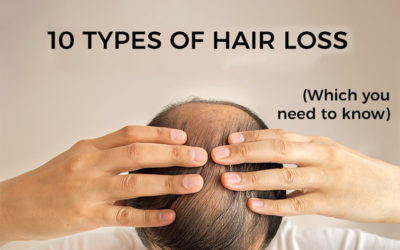Hair loss is something that pretty much every single human being struggles with at some point or another in their lives. You look in the mirror, and suddenly you wonder, why there is a bit of thinning in a certain area.
You ask yourself, are you imagining things or is it actually there? And having convinced yourself, you go around asking others, if, indeed, there is hair loss in that particular area, and maybe even other parts of the scalp.
Having gone through that process – and that in itself is quite a painful and time-consuming process (the discovering, the checking, the panicking, the asking and eventually the accepting) – the next question is usually:
Why?
Why is my hair falling out? Is there a particular reason? Is it more than normal? Is it the most common Androgenetic Alopecia i.e. male pattern baldness or female pattern? Or is it something else? Something a little more complicated perhaps?
Finding out just why your hair is falling out is key to taking measures to stop it or at least control it as much as you can
Types of Hair Loss
1. Androgenetic Alopecia:
This form is the most common, and male pattern baldness, the one that most men get as they grow older, comes under it. As does the female pattern hair loss.
While male pattern hair loss could eventually lead to complete baldness, female pattern hair loss is typically the thinning of the hair.
There can be several factors as to why someone gets it – unfortunately, in today’s stress-filled world, androgenetic alopecia takes hold much earlier than normal – but there is no sure shot cure or treatment for it.
Male-pattern baldness – the classic one – begins around the temple and the top of your forehead, to form a kind of V shape that you see quite frequently.
Eating healthy and, most importantly, keeping stress out of your life, will considerably reduce the chances of you getting it, or at least, delay it until that time, when you can at least embrace it a little better.
2. Tellogen Effluvium:
Another big-sounding name and a condition that is probably the second most common form of hair loss after androgenetic alopecia.
This name is derived from a resting phase of the hair follicle, with that hair follicle then deciding to stay rested. To clarify it a little more, it is when the growth phase of the hair follicles, after the resting phase, fails to start.
The result is considerable thinning of hair, usually found on top of the scalp, rather than on the sides, and the considerably larger hair fall.
While it is natural to lose around 100 hairs per day, people suffering from Tellogen Effluvium could lose up to 500 hairs per day, making that hair loss problem a whole lot more complicated.
The good news, though, unlike pattern baldness, this is much more curable. You just need to find the reason behind the problem. Telogen Effluvium can be caused by a recent medical procedure, malnutrition, mineral deficiency, if you aren’t taking your vitamins properly, illness or that most common affliction of the modern world – stress.
Find out what is causing it and Tellogen Effluvium can be stopped, although it could cause quite a few problems if it continues for a considerable period of time. There are ways to get it treated, though, which is the good news.
3. Alopecia Areata:
With the third big-sounding hair loss condition, we are in autoimmune territory. This is, unfortunately, one of the more undesirable forms of hair loss. Alopecia Areata, or commonly known as spot baldness, occurs when you start losing hair in some or all parts of your body in patches.
There will be large bald spots formed, particularly on the scalp, with the size roughly that of a coin. Since it is an autoimmune disease, it is a lot more complicated to treat and there is no full cure for the condition.
Alopecia Areata is usually handed down, as in it is hereditary.
Steroids – cortisone injections – are given to try and treat the condition, while preventive measures like ensuring you put plenty of sunscreen and wear sunglasses to protect the eyebrows are recommended.
4. Anagen Effluvium:
This is a condition you might have seen often enough on your television screens. Anagen Effluvium is a form of rapid hair loss, most commonly found when the subject has undergone a major medical procedure, particularly chemotherapy.
However, because this form of hair loss occurs as a result of a procedure or treatment, it isn’t permanent. Hair will usually grow back normally, once the procedure or treatment is done.
5. Tinea Capitis:
Also known as scalp ringworm, this is a form of hair loss that occurs due to a fungal infection. It is usually found in children, with the infection leading to hair loss in clumps, leading to circular bald spots.
The affected areas of the scalp can also turn red and scaly, with itching a common problem of the infection.
Antifungal medication is the solution to fighting Tinea Capitis aka scalp ringworm, and, once it is properly treated, hair grows back in its normal pace in those affected areas.
6. Scalp Folliculitis:
After fungus, comes bacteria. This is a bacteria-caused infection, which leads to the hair follicles become inflamed. If you look at the scalp, it might even seem to you like the area has acne.
However, while hair might continue to grow around the affected area in the initial stages, ignoring it will lead to hair loss. If not treated properly, the infection or inflammation can lead to permanent hair loss in those areas where the bacteria has been affected.
7. Traction Aloepcia:
This is a specific form of hair loss, caused by constant stress to the hair follicles. It normally occurs to people who wear tight ponytails, buns or braids and can lead to receding hairline around the temples.
8. Cicatricial Alopecia:
This is a rare form of alopecia, where the hair follicles eventually get replaced by scar tissue. As a result, this form of hair loss is also known as scarring alopecia.
Itching, swelling and redness of the scalp of a severe nature are symptoms of the condition. While loss of hair is gradual and happens over a considerable period of time, it can lead to permanent hair loss.
9. Central Centrifugal Cicatricial Alopecia:
This is a form of hair loss that can occur quite easily in the modern world as it comes as a result of the usage of hair products or machines.
Be it chemical hair products that damage your hair or the excessive use of blow dryers, hair straighteners, curling irons or even putting on hair extensions. All of this does put you at risk of Central Centrifugal Cicatricial Alopecia.
As long as it is diagnosed, and treated accordingly, hair loss can be controlled and brought back to its normal self.
10. Trichotillomania:
One of the more severe forms of hair loss, which comes under the mental or impulse control disorder sphere.
It is a condition which leads to people wanting to pull out their hair from its roots. This leads to bald patches on the scalp and even on the eyebrows and eyelashes.
Hair is such a precious part of our lives. So taking care of it is essential if you want a healthy, lively and head-turning head of hair.
Related Posts
Lip Fillers: Tracing the History and Advancements in Cosmetic Enhancement
Lip fillers are a trending cosmetic treatment...
Explore the Advantages of Skin Lightening Treatments
With the high beauty standards, personal...
12 Essential Hair Care Tips this Summer
Summer is a time for outdoor adventures and...



